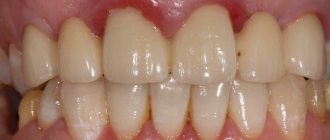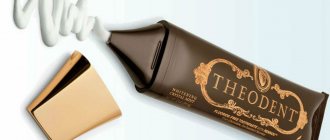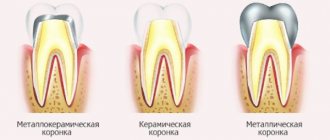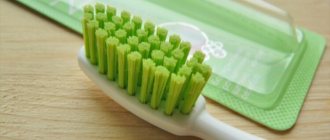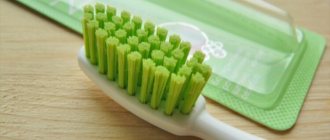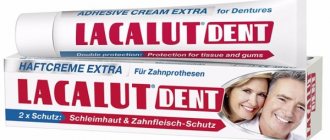January 10, 2018
Dental crowns today are one of the most common methods of prosthetics. They are installed when the upper part of the tooth is destroyed by more than half, the aesthetics are compromised, stains, chips are present, there are gaps in the row or the tooth is in an incorrect position. Another indication is the absence of one or many teeth, but in this case the crowns are part of other prostheses, for example, bridges or removable ones, or are fixed on implants.
Dental crown
Modern crowns are created from a variety of materials, and each type of prosthesis has differences in terms of cost, durability and aesthetics. UltraSmile.ru portal have prepared an overview of the most popular types of modern crowns, as well as useful recommendations that will help you not make a mistake in your choice.
Metal composite crowns
Such prostheses are created from metal alloys and covered with a composite material on top. Their main advantages are low cost, good aesthetics, and fairly high strength. The service life with careful care is no more than 5 years, but in case of minor chips and damage, the crowns can be restored directly in the oral cavity at a doctor’s appointment. The price of crowns made of metal composite is from 2,500 rubles.
Metal composite crowns
It is better to use them on the lateral teeth, because the composite may become dull over time and will need to be polished. In addition, the material is susceptible to coloring pigments from food. Also, abrasion of the composite can expose metal, which in its pure form does not look very nice and forms a blue edge in the gum area.
On a note!
Metal composite is most often used as temporary prosthetics. This option is especially suitable for dental implantation with immediate loading, since it is light and flexible.
How to install sprayed crowns
Spray-coated metal dentures can be fixed to both the front and chewing teeth. If the smile area is to be restored, it is recommended to give preference to white products coated with zirconium. They look better than others against the background of their natural “neighbors.”
When working with molars, structures coated with other alloys can be used. This is explained by the fact that they are not noticeable to others, but at the same time they are reliable and durable.
The dental appliance installation process includes four basic steps:
- Preparatory activities.
- Preparation of a damaged natural crown.
- Taking impressions.
- Installation.
Each of them is very important and takes a lot of time.
Preparatory activities
First, the dentist carefully examines the patient’s oral cavity and talks with him. He finds out the client’s wishes and checks whether he has any contraindications to the use of metal prostheses.
Then he takes pictures, studies them and proceeds to depulpation - removal of the dental nerve and cleaning of the canals. This procedure is necessary to prevent pain from occurring in the treated tooth in the future. After all, then you will have to remove the crown, treat pulpitis and make a new dental prosthesis, and this is expensive and troublesome.
Stump formation or preparation
To give the remaining tooth the desired shape, it is processed in a certain way. At his discretion, the doctor can use the following preparation methods:
Air with abrasive. This method is suitable if you need to remove a small outer layer. A mixture of air and abrasive powder is applied to the tooth under high pressure. Eventually, the outer covering of the teeth is removed.- Laser. Innovative laser equipment is used, which carefully processes the tooth surface and removes its excess. In this case, the tooth does not heat up. Consequently, burns of soft tissues and mucous membranes are completely excluded. Chips do not appear on the molar.
- Ultrasound. Preparation using this method is also painless. The destroyed crown is carefully processed, giving it the required shape. The pulp does not overheat during operation.
The doctor always decides which method to prefer, based on the characteristics of the clinical situation.
Taking impressions
When the stump is prepared, the patient is invited to take impressions. This procedure is absolutely painless. The doctor applies a special gel to a special plate, then carefully places it on a row and asks the patient to bite down on the device.
Then he carefully removes the resulting impression and immediately transfers it to the dental laboratory. Based on it, an individual metal prosthesis with coating is made.
Installation
Before the crown is finally installed, the patient is invited to try on the manufactured system. If any discrepancies are found, the device is adjusted and re-fitted. Continue this way until a perfect fit is achieved.
Afterwards, the crown is sprayed and fixed with permanent cement. Immediately after the glue hardens, a person can use his new tooth as if it were his own. At first, the presence of an artificial unit in the mouth often causes unusual sensations, but they quickly pass.
Ceramic composite crowns
Such crowns have excellent external characteristics, since they are created from a material that includes both ceramics and composite. They are hypoallergenic and do not cause irritation to the mucous membrane. A chipped composite can be easily adjusted right in the dental chair. Dentures will last up to 10 years.
Ceramic composite crowns
Crowns are less durable than metal-ceramics. Well suited for restoring teeth in the smile area. It is also an excellent option for implant-supported dentures. True, to acquire a “highly aesthetic” smile you will have to pay accordingly. Their price starts from 7,000 rubles.
Competent care
If you properly care for metal dentures, they will last a very long time. Here are the rules that the patient must adhere to after fixation:
- Do not eat very hard foods (nuts, etc.).
Use high-quality dental floss on a regular basis. It is important to promptly clean the interdental spaces from food debris.- In the morning and evening, rinse your mouth with antibacterial compounds, self-prepared saline or soda solutions.
- Brush your teeth at least twice a day, and preferably after every meal. The brush should be of medium hardness and made of artificial bristles.
- Minimize smoking. The fact is that tobacco smoke causes the prosthesis to turn an unsightly gray color.
If the restored unit becomes mobile, the gums at its base become inflamed, you should immediately make an appointment with the dentist. The doctor will conduct the necessary diagnostics and tell you what to do to eliminate unpleasant symptoms.
Metal-ceramic crowns
There are two options for prostheses: some are a durable metal frame made of inexpensive alloys, others are made of noble metals. In this case, both are covered with a thin layer of ceramics, which is baked in an oven. Metal-ceramic “teeth” are very durable, can withstand heavy chewing loads, and will last 10 years or more. In addition, this will be the best option for restoring teeth in terms of price and quality - you can spend 5-6,000 rubles. But the average cost in Moscow is from 7-10,000 rubles.
Metal-ceramic crowns based on gold
Another option is shoulder crowns. They have a ceramic coating applied not only to the top, but also to the base itself. Thanks to this, the gums do not come into contact with the metal, a loose fit of the prosthesis to the tooth is eliminated, the formation of allergic reactions is minimal and the oxidation of the metal from contact with saliva is minimized - as a result, darkening of the gums is avoided.
Is a metal crown on a chewing tooth harmful?
There is no clear answer to this question. I think it is harmful, although each case is individual. There are patients for whom the placement of steel products is contraindicated due to a genetic characteristic of the body that causes allergic reactions to metal, including galvanism, when the potential difference of metals in the mouth begins to produce an electric current. And this is accompanied by quite unpleasant sensations.
Therefore, before prosthetics, it is recommended to undergo a test for allergic reactions. If the result is positive, the client is offered an alternative type of prosthesis - metal-free crowns on the teeth.
Installation of non-metal crowns
on teeth I offer patients in such cases:
- If you need to restore teeth with a high functional load.
- The bone tissue of the tooth is destroyed to the base.
- The closing surface of the chewing units is heavily worn.
- Installation of bridge structures is required.
The rigidity of the frame and the duration of wearing the crown depend on the method of manufacturing the prosthesis. Today, only cast elements are used in prosthetics. They fit tightly to the base, preventing the penetration of harmful bacteria. Therefore, the risk of developing caries on prosthetic teeth, after high-quality installation of metal crowns, is zero.
All-ceramic crowns
On a note!
Crowns are universal in use and can be fixed both on the remaining parts of a living tooth and on a tooth without a nerve, on a pin or stump inlay.
In all cases, they completely recreate the anatomy of the tooth, its aesthetics and allow you to return full functionality. Dental ceramics are less durable than metal ceramics, but they look much more aesthetically pleasing. The translucency of the ceramic base allows for ideal restoration of the front teeth. However, due to their fragility, the service life of the prostheses will be from 5 to 7 years.
All-ceramic crowns
Today there are also pressed ceramics, which are much more durable than ordinary ones. Such dentures look even better and last many times longer. The price of all-ceramic crowns starts from 8,000 rubles and can reach 20,000 rubles if pressed ceramics are used.
Manufacturing method
Coated crowns are made in two ways: solid casting based on an anatomical cast, or stamping. When applying the coating, the prosthetic part is disinfected and polished, after which the facing layer is etched into the base due to exposure to high temperature.
The technology for creating stamped products involves the use of sleeve blanks processed in accordance with the prototype obtained when taking an impression of the dentition. Such models are distinguished by their affordable cost, durability and functionality, however, it is important to consider that the stump base, located under the “cap,” inevitably wears out under the influence of mechanical loads.
Zirconium crowns
This option is suitable for those who value the highest aesthetics, maximum strength, high wear resistance and durability. Such dentures are not created manually, but using milling and computer technology of the latest generation, therefore they repeat the structure with the highest accuracy and are also precisely positioned on the tooth. In addition, zirconium is completely compatible in its characteristics with the human body, has light transmission like natural teeth and is almost indistinguishable from the natural shade of enamel.
Zirconia crowns
Of course, you will have to pay many times more for zirconium dioxide crowns than for other prostheses - at least 12,000 rubles apiece, but they will justify their cost and will last about 20 years.
When choosing dental crowns, you should pay attention not only to the price, but also to other characteristics of the prostheses, to the appropriateness of their use for a certain clinical picture. Then the choice will be correct and will meet the main expectation from going to the dentist - getting a beautiful and functional smile.
The most common materials for metal prosthetics
Today, modern dentistry uses the following alloys for the production of metal crowns:
- steel with or without gold plating;
- gold;
- silver with palladium;
- cobalt and chromium;
- titanium;
- platinum.
In Russia, gold is often used as a material for making dental crowns. Dentists value it primarily for its softness, and, therefore, a tight fit to the damaged tooth and a gentle attitude towards the enamel of neighboring teeth. At the same time, gold is a fairly strong and corrosion-resistant material that can last for decades.
Disadvantages of metal prosthetics
The main disadvantage of metal prosthetics for most patients remains the need to prepare teeth before placing crowns. But thanks to modern dental painkillers and ultra-precise technology, the process of removing a thin layer of tooth enamel occurs with minimal discomfort for the patient.
Contraindications for the use of metal dental prosthetics:
- Allergic reactions to a specific metal of the prosthesis.
- The need for prosthetics of the front teeth.
- Tooth root resorption.
Watch the video: Types of dental crowns
Notice
: Undefined variable: post_id in
/home/c/ch75405/public_html/wp-content/themes/UltraSmile/single-item.php
on line
45 Notice
: Undefined variable: full in
/home/c/ch75405/public_html/wp-content /themes/UltraSmile/single-item.php
on line
46
Rate this article:
( 2 ratings, average: 3.00 out of 5)
dental restoration
Solid crowns: indications and contraindications
Indications
- Serious destruction of the coronal part of the tooth, in which its restoration with filling materials or inlays is impossible;
- Irregular shape of native dental crowns, which cannot be treated with orthodontic techniques;
- Intense pathological abrasion of hard dental tissues, in particular enamel;
- The need to create support for the bridge structure.
Contraindications
Absolute:
- Living tooth nerve in children and adolescents;
- Severe periodontitis.
Relative:
- Serious malocclusion with incisal overlap;
- Uncontrolled teeth grinding;
- Lack of height of the crown part of the native tooth against the background of serious defects in the dentition;
- Allergy to the manufacturing material.
Comments
[…] oral cavity only as part of dentures: inlays, crowns, fillings, as well as implants. Metals react [...]
Galvanic syndrome or electric current in the mouth. What to do? (09/01/2018 at 09:02) Reply to comment
[…] for example, they compare favorably with metal and metal-ceramic products precisely from the point of view […]
Methods for making ceramic dentures. How are ceramic dentures made? (09/03/2018 at 09:00) Reply to comment
[…] bridge, this method does not involve installing crowns on the supporting teeth, and therefore is called gentle. They highlight […]
Methods of prosthetics without grinding teeth, descriptions, advantages and disadvantages (09/03/2018 at 09:03) Reply to comment
Write your comment Cancel reply
Promotion for installation of crowns in Moscow
If the tooth is properly prepared for crown installation, further prosthetics can be performed. A tooth will have to be removed only if it was subject to removal before prosthetics.
- Depulpation must be carried out necessarily
Innovative dental technologies and high professionalism of the doctor make it possible to install crowns on living teeth.
Today it is even possible to cure pulpitis and caries without removing the denture.
Contraindications
It is not possible to install a crown on every tooth - there are certain situations when the feasibility of its installation is highly questionable. Contraindications include:
- pathological tooth mobility;
- insufficient height of the tooth crown - in this case the prosthesis will sink;
- chronic inflammatory processes in the mouth;
- unfilled canals of the prosthetic tooth.
At AcademyDENT, doctors carefully follow all indications and contraindications for prosthetics, so we have an extremely low percentage of complications.
Advantages and disadvantages of solid-cast permanent crowns
Solid crowns have a number of advantages, and therefore are widely used in dentistry. This:
- Relatively low cost, which is lower than that of a number of other prostheses;
- Excellent wear resistance;
- High strength and service life of about 20 years;
- Wearing along with the original enamel;
- Providing the anatomical shape of the restored tooth.
We should not forget that preparation for a solid crown does not require the removal of a large amount of tissue. This became possible thanks to the small thickness of the structure, which does not exceed 0.5 mm. Unfortunately, if a patient wants a perfect-looking reconstructed unit, this design will not work for them. Perhaps the only drawback of solid crowns is their poor aesthetics. They have a metallic color, which will undoubtedly spoil the appearance of the dentition. At the same time, when using special cladding, the metal can be hidden, but this still will not provide the desired aesthetics.
